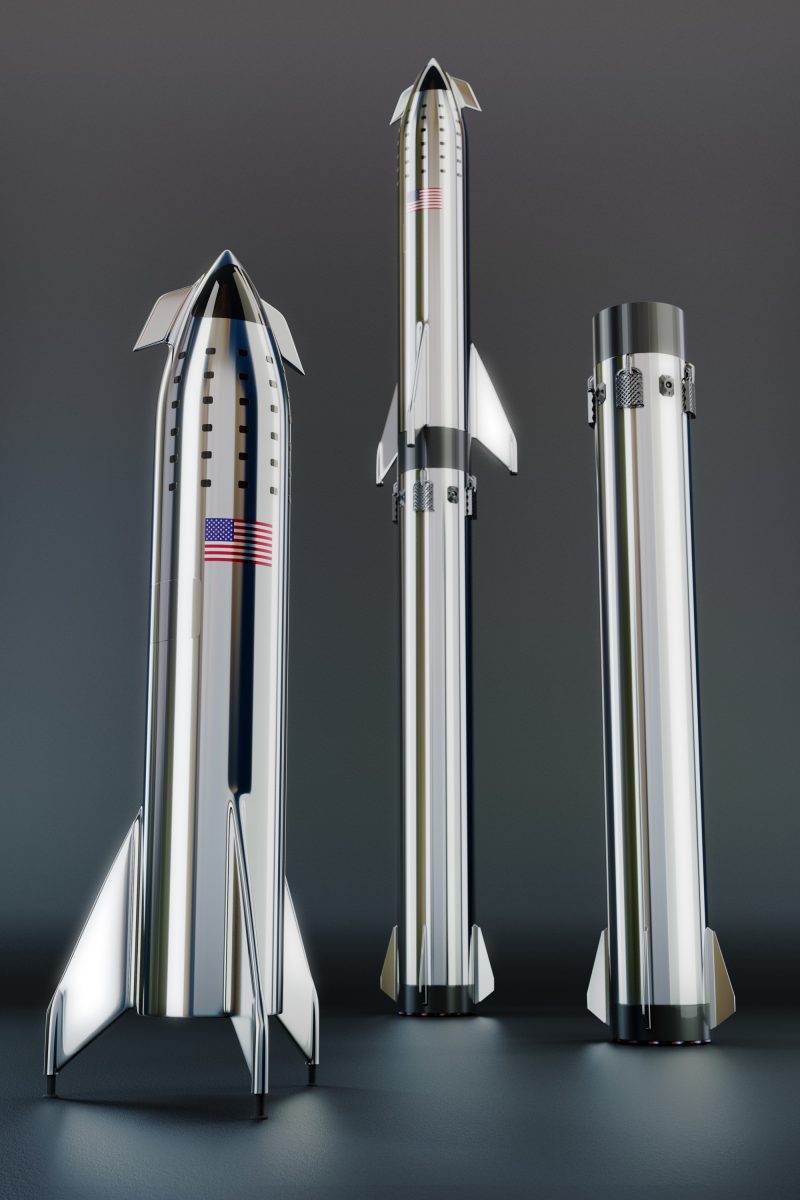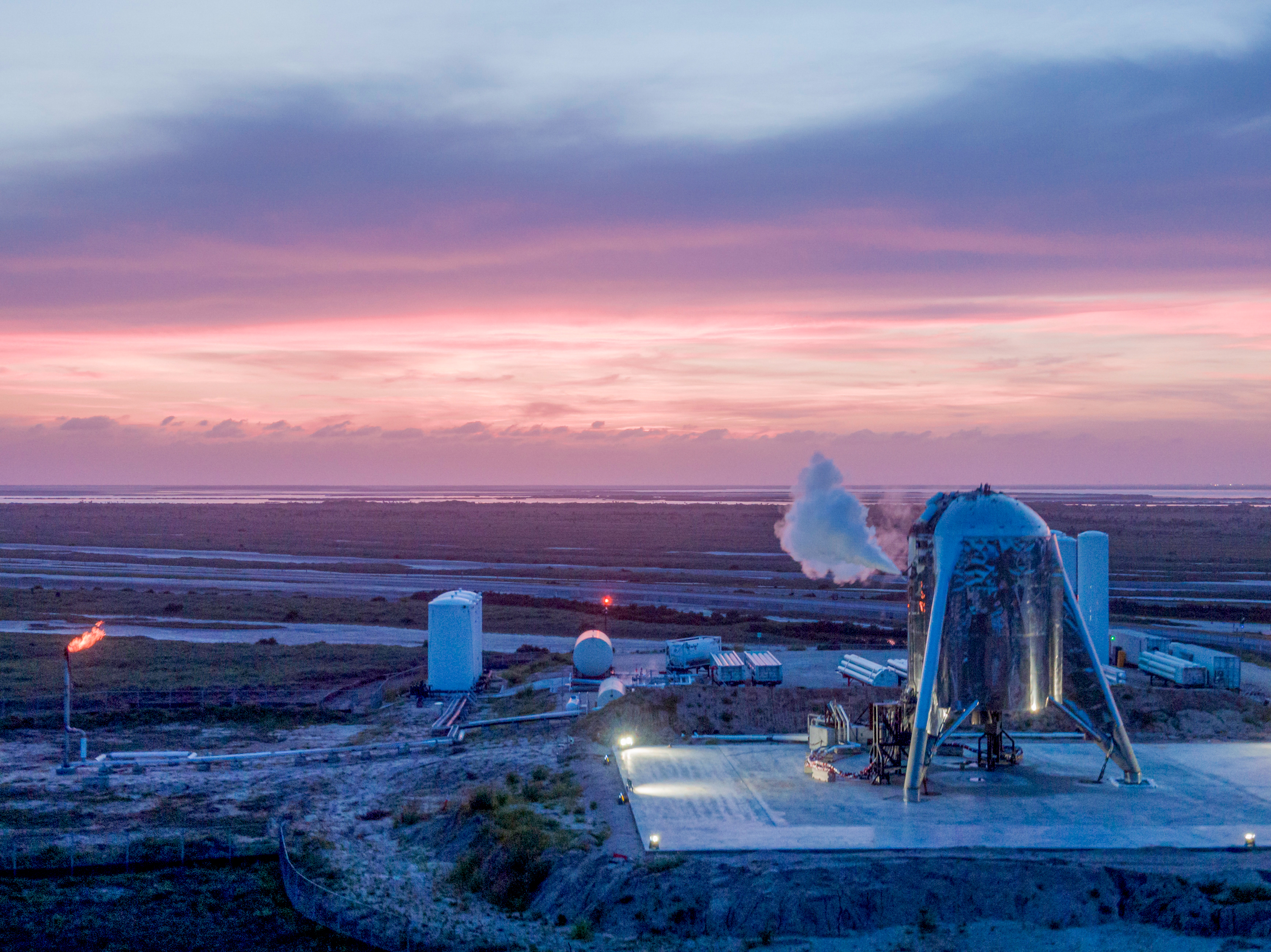- SpaceX plans to launch a small rocket ship called Starhopper in Texas on Wednesday. Although the vehicle was briefly engulfed by a fireball last week, it emerged mostly undamaged.
- Starhopper is a test bed for a much larger vehicle, called Starship, which is being designed to send people to the moon and Mars.
- Elon Musk, the rocket company’s founder, says Starhopper should rocket about 65 feet (20 meters) off the ground, hover, move sideways, and then land back on its launchpad.
- Locals have set up live video feeds to broadcast the attempt, which is scheduled for Wednesday between 3 p.m. to 1 a.m. ET (2 p.m. to 12 a.m. CT).
- Visit Business Insider’s homepage for more stories.
SpaceX is about to launch a stubby steel rocket ship called the Starhopper above the southern tip of Texas.
An attempt this evening would be SpaceX’s second in as many days, following a try on Wednesday that engineers cut short right after ignition of Starhopper’s single rocket engine.
To make sure everyone can follow SpaceX’s flights in Boca Chica, Texas, a group of local residents plans to broadcast the attempt live on YouTube. SpaceX may also post its own live-streaming video closer to the time of the test. (We’ve embedded video players toward the end of this post and will update them as needed.)
The rocket ship is called Starhopper, and it stands more than 60 feet tall and 30 feet wide. A single Raptor rocket engine is attached to its base, and SpaceX test-fired that engine on July 16. The test was successful, even though it resulted in a big yet brief fireball.
On Monday, the Federal Aviation Administration also issued a flight restriction for airspace over SpaceX's launch pad to "provide a safe environment for rocket launch and recovery."
Road closures for the area outline SpaceX's flight window, and the most recent notices suggest the company will attempt a launch on Thursday between 3 p.m. to 1 a.m. ET (2 p.m. to 1 a.m. CT).
SpaceX will use that protected space to fly the Starhopper vehicle about 65 feet (20 meters) into the air, hover, move sideways, and land back on its launchpad near Boca Chica Beach, according to a tweet from founder Elon Musk.
Starhopper isn't designed to fly to orbit; rather, it's designed to test technology for a far larger and more powerful launch vehicle called Starship. That system could stand nearly 400 feet tall and be capable of sending about 100 people and more than 100 tons of cargo to Mars or the moon.

The launch system is also being designed for full reusability, which may vastly reduce the cost of accessing space. Other versions could be built to deploy hundreds of satellites at a time or rocket paying passengers halfway around the world in about half an hour.
SpaceX fired up Starhopper for the first time in April. That test secured the rocket ship with giant bike-chain-like tethers on its legs, and the vehicle lifted just a few inches off the ground. A subsequent test lifted it farther, but not by much. This week's test will launch the rocket ship completely untethered.
A SpaceX spokesperson told Business Insider in an email that the hop-and-hover test is "one in a series of tests designed to push the limits of the vehicle as quickly as possible to learn all we can, as fast as we safely can."
The launch is not guaranteed to happen, or even go well, though: "As with all development programs, the schedule can be quite dynamic and subject to change," the spokesperson said.
When a Twitter user asked Musk if there would be livestreaming video of the launch, Musk said "sure." On Wednesday night, SpaceX shared a broadcast recorded from an aerial drone.
The company is likely to follow through again (we'll update this story if it does), but in any case a group of locals has also set up a moderated live feed of Starhopper's launch site.
Watch Starhopper's biggest hop attempt yet on YouTube
Maria Pointer, who lives near SpaceX's Texas launch site, said she teamed up with fellow local Louis Balderas to create the two-camera broadcast below, which runs nearly 24 hours a day.
The LabPadre video feed has one camera that can rotate 360 degrees and is on the Pointers' property; it shows the launchpad from about 1.8 miles away (though it has a powerful zoom). The second camera is on top of a building in South Padre Island, nearly 6 miles away from SpaceX's launchpad.
Pointer told Business Insider that the feed's slogan was "showing the valley to the future" because "kids in Brownsville need to see what's going on" at SpaceX's launch site.
The cameras often switch between views, show live weather and launchpad conditions, and display other information.
As another option, Tim Dodd, who runs the Everyday Astronaut channel on YouTube, is also live-streaming a view of the launch site (below).
Both feeds showed Starhopper's test-firing and subsequent fireball last week. Musk said the flames were caused by methane fuel that leaked.
But because Starhopper is made of a rugged stainless steel similar to the kind used in pots and pans, the accident caused "no major damage," he said.
"Big advantage of being made of high strength stainless steel: not bothered by a little heat!" Musk added.
What time SpaceX may try again to launch Starhopper
If the activities and timeline of Wednesday's attempt are any indication, SpaceX will likely try again to fly Starhopper sometime after 6:02 p.m. ET. That's when the company is supposed to launch an uncrewed cargo spaceship for NASA from Cape Canaveral, Florida.
Called Commercial Resupply Services-18 (CRS-18), the rocket was supposed to lift off on Wednesday, too, though 1,000 miles away in Florida. Poor weather conditions foiled that launch attempt, so now SpaceX will try again today to launch that mission.
Since tracking antennas for CRS-18 are located in Boca Chica, Texas, SpaceX will likely focus its resources on that mission first - then get back to Starhopper's test flight an hour or two after a liftoff or scrub.
This story has been updated with new information. It was originally published on July 16, 2019.

